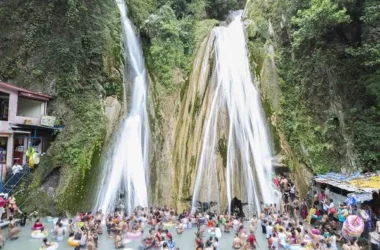Guide to Public Transportation in Bangkok: With the rush hour lasting from dawn to dusk, walking around Bangkok can test the strongest nerves. Colorful taxis always ply the main streets of the city.
Fortunately, there are other options! The BTS (Skytrain), MRT (subway), and river taxi networks are extensive. Unless you’re living near the Khao San Road area, where trains don’t yet arrive, avoid spending your travel time sitting in gridlock traffic.
How to Ride the BTS Skytrain
Bangkok’s SkyTrain is an excellent option for getting between busy areas, especially along Sukhumvit Road where traffic is often at a standstill. It’s nice to see all those brakes lights down as you accelerate from above! The heart of the Skytrain network is Siam station, a massive interchange connecting two BTS lines: Sukhumvit (light green on maps) and Silom (dark green on maps).
- Hours: Trains run every 5-10 minutes from approximately 5:30 a.m. to midnight; The schedule varies from about 30 minutes depending on the station. Ticket offices are open from 6 a.m. to midnight, but large public holidays can affect hours.
- Fares: Prices are calculated based on distance and range from 16-59 baht (between 50 cents and $1.90) for a single trip. Ticketing machines clearly display the cost from your current station. The average cost of a one-way trip is usually a dollar or less. A day pass costs 140 baht (about $4.50) for a 24-hour unlimited ride.
- Ticketing: Uses ticket cards available from BTS machines (many only accept coins) or ticketing windows (if it is open). Tickets are not checked on trains, but they do require you to exit the turnstiles at your destination, so keep that handy! If you lose your ticket or stay “in” for more than two hours, you will have to wait for an attendant and pay the maximum fare.
- Accessibility: Some BTS stations have escalators while others have multiple stairs to climb. Interchange for the river taxi system, all stations have lifts except Safan Taxin station.
- Getting to and From the Airport: Phaya Thai Station on the Sukhumvit Line connects to the Airport Rail Link.
Details about individual station schedules and fares can be found on the official BTS website.
How to Ride the MRT Subway
Bangkok’s Metropolitan Rail Transit feels a bit slow compared to the SkyTrain, but it’s useful in every way. More than 400,000 commuters use the subway daily to avoid surface traffic. The MRT currently has two lines: the Blue Line (the busiest) and the Purple Line.
The interchange for the Blue Line and Purple Line is Tao Poon Station.
- Hours: The MRT operates from approximately 6 am to midnight. Trains run every 5-10 minutes depending on the time of day.
- Fares: Prices are based on the distance covered and 15-50 baht (between 45 cents and $1.60). An average-length trip will cost about a dollar or less.
- Ticketing: Ticketing machines for the MRT accept small denominations of Thai Baht and issue an RFID token that is tapped for entry to the platforms. The token has to be surrendered to exit.
- Accessibility: All MRT stations have lifts.
- BTS Transfers: The MRT crosses the BTS Skytrain at Sala Deng, Ashoka, and Mo Chit. You will need to get a new ticket.
- Arrival/Departure from the Airport: Phetchaburi station is connected to Suvarnabhumi Airport (BKK) at Makkasan station on the airport rail link.
Fares and schedules can be seen on the official MRT website.
Using the Trains in Bangkok
Located near Chinatown, Hua Lamphong Station serves as a hub for long-distance surface trains and the MRT. The aging site dates back to 1916 and is set to be converted into a museum in 2021. The new station in Bang Soo will become the largest railway station in Southeast Asia. Outside Bangkok, Hua Lamphong Station is commonly referred to as Krungthep (Bangkok) Station.
The expected restrictions – no smoking, food, and alcohol – apply at all stations and trains in Bangkok. Some visitors are surprised to learn that photography and video are also banned.
On all public transport options in Bangkok, you should be prepared to give up your seat if any monks and pregnant women are aboard.
How to Ride Bangkok’s River Taxi Boats
Many travelers do not use riverboat taxis in Bangkok unless staying at one of the riverside hotels in Silom. The colorful-flag system and the quick, chaotic loading and unloading on the ferries (with the whistling) may be intimidating at first, but taking advantage of the mighty Chao Phraya River only makes sense to avoid traffic.
Plus, river taxis are an affordable way to cover some distance in Bangkok. Fares can be as cheap as 30 cents for a scenic trip! A full-day pass costs just $3 (approximately 100 baht). Sathorn Pier is the nearest stop to BTS Skytrain station (Safan Taxin Station on the Silom Line).
How to Ride Buses in Bangkok
Bangkok’s soot-filled buses are the slowest, most complicated option for getting around – tourists rarely bother. Pay to the conductor on the bus, and small changes are available. Don’t expect much help in English.
Other Transit Options
The least efficient way to get around Bangkok is by road. Regardless, sometimes you have to, especially if living in a neighborhood like Banglamphu where public transportation options are limited.
Taxis in Bangkok
With a strong taxi “mafia”, you’ll need some luck on your side to have a good taxi experience in Bangkok. It is still possible to find an honest driver, but patience is required.
Meters are installed in all taxis. Many drivers shy away from using them as they like to keep the increased fares off the record. If a driver quotes you one price instead of switching you to the meter, try another. Taxis to your business will often line up behind each other.
- Use taxi-hailing on the go instead of using taxis parked in tourist areas.
- Avoid freelance drivers. Fast-dressed drivers with well-maintained cars are more likely to work for real taxi companies than for the local taxi mafia.
- Make sure the driver will use the meter after driving the taxi.
- Once in a taxi, follow the route on Google Maps. Doing so can sometimes discourage drivers from driving the long way because you asked for a meter.
- Tipping is not expected, but you can increase the fare thanks to the friendly service.
- Passengers are responsible for any tolls.
Note: Never enter any vehicle in Bangkok without agreeing to a set fare or use of the meter. Once on your way, you are obliged to pay whatever the driver asks.
Ridesharing Services in Bangkok
Ridesharing services cost a bit more than taxis, but you can avoid a lot of hassle and hustle and bustle. In March 2018, Uber handed over operations to Grab, Southeast Asia’s preferred ridesharing app.
Grab works much like Uber, however, you can choose to pay with cash. If you have a dispute with a rogue driver (uncommon, but it does happen) this isn’t a bad idea. Rent can still be bargained or denied and will not be automatically debited from your credit card.
Understand that rideshare drivers are often targeted and harassed by the local taxi mafia. Maybe they want to take you to a place more discreet than the front door. Many drivers do not put a sign on their car.
Tuk-Tuks in Bangkok
Riding a tuk-tuk is considered one of the quintessential Thailand experiences. To enjoy, you have to negotiate rent and rule out potential scams. Definitely do not agree to stop at the stores. Tuk-tuks are fun but no cheaper than taking metered taxis, and without seat belts, they are less safe.
Renting a Vehicle
Although you can technically rent a car or motorbike to drive in Bangkok, you will regret it. Seriously, don’t do that. Wait for something far more relaxing and less dangerous to enjoy renting a scooter. According to the World Health Organization, Thailand has one of the highest traffic-related mortality rates in the world.
Tips for Getting Around Bangkok
- Keep your small change. Many ticketing machines for BTS only accept coins. If you don’t have coins, you’ll have to wait in long queues for the cashier or at ticketing machines that accept paper currency.
- Use new tickets for transfers. Unfortunately, a common ticketing system for the BTS Skytrain, MRT Underground, and Airport Rail Link are still in operation. You will have to surrender the old ticket at the time of transfer and buy a new one at the interchange.
- Buy cards for longer stays. If you’ve been in Bangkok long enough, consider purchasing rechargeable smart cards for BTS and MRT. You can avoid the queues at the ticketing machines. People above 60 years of age get a 50 percent discount on adding credit to the MRT card.
- Avoid endorsing bad practices. Supporting unscrupulous drivers harms local people through cultural change. Local residents sometimes find it difficult to drive taxis because drivers will wait for a paying tourist who does not demand a meter.
More About Bangkok









